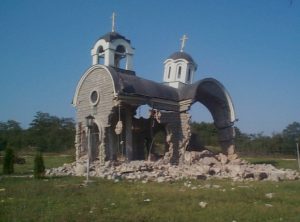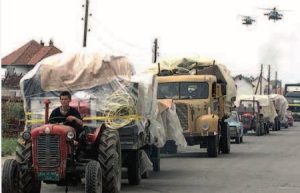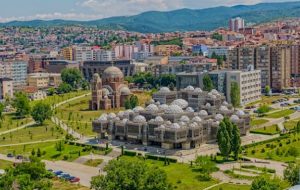
Paris, October 17 (Mira Popovic)
The ill-treatment and ouster of Serbs in Kosovo, the land of their forefathers in the presence of KFOR forces, the systematic devastation of the Orthodox sacred places in the “Serbian Jerusalem”, but also the grave aftermaths of NATO bombing across Serbia – these are the main themes of the dossier published by the Paris weekly “Le Figaro Magazine” on several richly illustrated pages.
“The Serbian tragedy hidden from you” is the cautioning common title of several articles, documenting the different aspects of the moving story about the sufferings of the Kosovo and Metohija Serbs, “the martyred nation” and the uncertainties awaiting ten millions of Serbia’s citizens with the forthcoming winter.

The author of one of the articles never forgot to remind his readers that Kosovo and Metohija are “the sacred Serbian, Orthodox land”. However, in spite of the 40,000 KFOR members’ presence “the devastation of the Serbian religious symbols in Kosovo and Metohija is spreading” and according to “the present rhythm of devastating the sacred Orthodox places in Kosovo and Metohija, the Serbian Jerusalem will soon become a historical memory only”, warns “Le Figaro Magazine” in the article bitterly titled “Here lies the soul of a sacred land”.

There is no dilemma for the author on why the Albanians have chosen the Orthodox churches and monasteries as the targets of their destruction: “By attacking the Orthodox churches and monasteries — more than 60 were destroyed since the war was over — the Kosovo Albanians have the right target: they are aiming at the very soul of the Serbian nation”, says he and adds: “If the West has never understood the essential ties of the Serbs to this land, the Albanian-Moslems know for sure what this is about. For the Serbs, Kosovo is the epicenter of their religion, culture and memory”.
Why? To the uninformed or to the ones that tend to ignore the irrefutable historical facts, matters could become more clear if they learn that the Serbian Orthodox Patriarchate was for two centuries situated in Pec (1557-1758) and Pec is still its honorary residence and also that in Kosovo and Metohija there are one thousand and four hundred Orthodox sacred places out of which “three quarters are dated from the Middle Age”.
Another thing: “From the Pec Patriarchate to the Decani monastery, with the Virgin Mary Church with five vaults in Gracanica, there are several jewels of the Byzantine architecture. By some miracle, these have survived five centuries of Ottoman occupation. The others were less lucky: the Prizren Mosque, raised upon the ruins of the Church of The Holy Archangel “. This was the “undertaking” of the Turkish Grand Vizier, an Albanian by origin, Sinnan Pasha, the same one who dug up the relics of Saint Sava, the founder of the Serbian Church and the father of the nation, to burn them down on the stake.
After the five centuries long thralldom, during which the Serbs were treated “as live-stock”, there were wars in which the Serbs-natives were “massacred and deported”. Finally, “this tormented nation of Orthodox religion”, although presenting the majority, was underrated and disfavored during the 50 years of Tito’s ruling as well, says the author of the article published in the “Le Figaro Magazine”.

As regards that period, Tito “who was a Croat, did everything to weaken the Serbian influence in the Yugoslav Federation”, explains the author, illustrating this with the example that one of Broz’s means was “to weaken the Orthodox Church by systematically favoring the Kosovo and Metohija Moslems“.
The example is very eloquent: “between the years of 1945 and 1980 (the year Tito died), Belgrade allowed the construction of about 700 mosques – opposed to only 300 Orthodox churches.”
The author Jean-Louis Turenne finally asks himself whether the so-called KLA will achieve – under the auspices of the United Nations – in what the Turkish Sultan janitors and the Tito’s regime failed?
“Pristina: a suitcase or a coffin”, is the title of one in the series of articles in the this week “Le Figaro Magazine” about the tragic sufferings of the Serbs in Kosovo and Metohija and the ethnic cleansing they have been exposed to since the arrival of KFOR to the southern Serbian province in June this year.

“Already 180,000 Serbs have left Kosovo and Metohija”, states Jean-Christophe Buisson in his article, describing all kinds of intimidations of the Serbs, “physical and psychological pressure”, to make them leave “the land of their forefathers”. To illustrate the situation, the author quotes the Croatian writer Dubravka Ugljesic on the suffering of the Serbs in Krajina: “To be a Serb in Krajina is the same as being Black in a place ruled by the Ku-Klux Klan!”
He thinks that what was applied to Krajina in 1994 corresponds to what is “today happening in Pristina.”

“Twenty years ago there were 40,000 Serbs living in Pristina, a year ago there were 20,000 and today there are only 400”, living “in fear and poverty”, says the author of the article.
Depicting the life of Serbs who stayed in Pristina, he says: “Racist graffiti and bullet holes are decorating the outer walls and doors of the (Serbian) homes. Without KFOR protection, they (the Serbs) are forced to organize by themselves the guarding of their roofs from the attacks instigated by the former KLA. Out of two days, one day they must become plumbers or electricians to repair the plumbing or the power facilities destroyed by the Albanians”.
” In Pristina and its surroundings where nearly 400 Serbs were abducted since the arrival of KFOR, nobody believes in the eventual multi-ethnic Kosovo anymore”, concludes the author of the article in “Le Figaro Magazine”, putting the essential questions of who, in such a situation, “could take seriously the nice statements delivered by Javier Solana or Hashim Thaqi”, on preserving the multi-ethnic Kosovo and Metohija.
The winter is nearing. For around ten millions of Serbia’s citizens, this means danger of cold and famine, warns the “Le Figaro Magazine” journalist, Jean-Louis Turenne in a special issue about the aftermaths of the NATO bombing of Serbia last spring.
“Having survived the bombing, the Serbs are now preparing themselves to face two other dangers, not less terrifying: famine and cold. For NATO has devastated the country”, causing damage estimated by the independent experts to thirty billion dollars.

The average income per person in Serbia is likely to be, following the NATO destruction, less than that of Albania which was, before the war in Kosovo and Metohija, the most poverty stricken country in Europe. There are other details given, as the one provided by UNICEF that during the NATO bombing 242 school buildings were either ruined or damaged in central Serbia, so that now the children cannot go to schools, that there is a shortage of medications, that the hospitals are overcrowded or insufficiently equipped‚?
“The catalogue” of the NATO bombing aftermaths upon the Serbian people is long and incriminating. Deciding to bring out to the French public the facts about the suffering of the Kosovo and Metohija Serbs and the Serbian people in general, “Le Figaro Magazine” by the thematic issue of articles titled “The Serbian tragedy hidden from you” has certainly helped to bring an unbiased and all-inclusive perception of all the seriousness and difficulty of the situation the Serbian people have found themselves in.
In its own way, the dossier is also a lesson to the ones still inclined to name a dangerous military adventure and the devastation of a sovereign country, “a humanitarian action.”